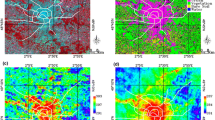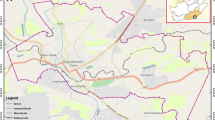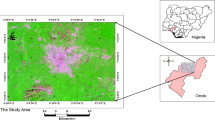Abstract
The main purpose of this study is to monitor the impacts of seasonal urban heat island based on the relationship between seasonal land surface temperature and Land Use/ Cover (LU/LC) fluctuations in Kabul city, the capital of Afghanistan in 2020.To do this, areas affected by Urban Heat Island (UHI) were detected. The relationship between UHI spatiotemporal fluctuations and LULC classes was also evaluated. The composition of Synthetic Aperture Radar (SAR) and optical Landsat 8 OLI images were used to extract the LU/LC type of the study area with higher accuracy for all seasons. Random forest supervised classifier was used to classify Kabul city into four different LU/LC classes (vegetation, water body, built-up, and bare land). Landsat 8 thermal bands were used to derive land surface temperature (LST) change patterns. The outputs revealed that the UHIs created in Kabul city have distinct causes depending on the type of LU/LC classes. The mean land surface temperature of the four LU/LC classes in different seasons demonstrated that the distribution mode of UHIs in the city was in line with the type of LU/LC. Based on overall assessments, the results revealed that nine districts in Kabul city (D-19, D-15, D-21, D-16, D-20, D-17, D-6, D-9, and D-1) are highly affected by urban heat islands. The UHIaffected regions in Kabul city, mostly consist of industrial parks, factories, the airport, industrial complexes, brick kilns, high volume of daily traffic congestion, densely populated, crush plant stations, and residential settlements. To validate the results, daytime and nighttime MODIS LST maps were generated. The daytime LST map similarly demonstrated that the spatial distribution of UHIs is related to the types of LU/LC. On the other hand, the results from nighttime LST maps revealed that nighttime heat islands are more intense than daytime heat islands, with the main concentrations of UHIs spreading towards the most populated areas in the central and eastern portion of Kabul city. This is due to the absorption of solar radiation throughout the day and emission during the nighttime. Remote sensing techniques were shown to be productive and economic, particularly in terms of minimizing the time for the evaluation of urban heat island variations based on the relationship between land surface temperature and LU/LC changes. Precise and updated remote sensing assessments of UHIs will pave the way for urban planners and land management organizations in addressing challenges related to the phenomenon.






Similar content being viewed by others
Data availability
The data used to support the finding of this study are included within the article.
References
Al Kafy A, Al Faisal A, Al Rakib A, Roy S, Ferdousi J, Raikwar V, Kona MA, Fatin SMA, Al. (2021a) Predicting changes in land use/land cover and seasonal land surface temperature using multi-temporal landsat images in the northwest region of Bangladesh. Heliyon 7(7). https://doi.org/10.1016/j.heliyon.2021.e07623
Al Kafy A, Al Faisal A, Rahman MS, Islam M, Al Rakib A, Islam MA, Khan MHH, Sikdar MS, Sarker MHS, Mawa J, Sattar GS (2021b) Prediction of seasonal urban thermal field variance index using machine learning algorithms in Cumilla, Bangladesh. Sustain Cities Soc 64(September 2020):102542. https://doi.org/10.1016/j.scs.2020.102542
Al Kafy A, Al Rakib A, Akter KS, Rahaman ZA, Al Faisal A, Mallik S, Nasher NMR, Hossain MI, Ali MY (2021c) Monitoring the effects of vegetation cover losses on land surface temperature dynamics using geospatial approach in Rajshahi City, Bangladesh. Environmental Challenges 4(June):100187. https://doi.org/10.1016/j.envc.2021.100187
Al Kafy A, Al Faisal A, Al Rakib A, Fattah MA, Rahaman ZA, Sattar GS (2022a) Impact of vegetation cover loss on surface temperature and carbon emission in a fastest-growing city, Cumilla, Bangladesh. Build Environ 208(June 2021):108573. https://doi.org/10.1016/j.buildenv.2021.108573
Al Kafy A, Saha M, Al Faisal A, Rahaman ZA, Rahman MT, Liu D, Fattah MA, Al Rakib A, AlDousari AE, Rahaman SN, Hasan MZ, Ahasan MAK (2022b) Predicting the impacts of land use/land cover changes on seasonal urban thermal characteristics using machine learning algorithms. Build Environ 217(February):109066. https://doi.org/10.1016/j.buildenv.2022.109066
AlDousari AE, Al Kafy A, Saha M, Fattah MA, Almulhim AI, Al Faisal A, Al Rakib A, Jahir DMA, Rahaman ZA, Bakshi A, Shahrier M, Rahman MM (2022) Modelling the impacts of land use/land cover changing pattern on urban thermal characteristics in Kuwait. Sustain Cities Soc 86(May):104107. https://doi.org/10.1016/j.scs.2022.104107
Amani M, Ghorbanian A, Ahmadi SA, Kakooei M, Moghimi A, Mirmazloumi SM, Moghaddam SHA, Mahdavi S, Ghahremanloo M, Parsian S, Wu Q, Brisco B (2020) Google Earth Engine cloud computing platform for remote sensing big data applications: a comprehensive review. IEEE J Sel Top Appl Earth Obs Remote Sens 13:5326–5350. https://doi.org/10.1109/JSTARS.2020.3021052
Arnfield AJ (2003) Two decades of urban climate research: a review of turbulence, exchanges of energy and water, and the urban heat island. Int J Climatol 23(1):1–26. https://doi.org/10.1002/joc.859
Atasoy M (2020) Assessing the impacts of land-use/land-cover change on the development of urban heat island effects. Environ Dev Sustain 22(8):7547–7557. https://doi.org/10.1007/s10668-019-00535-w
Ayoobi AW, Ahmadi H, Inceoglu M, Pekkan E (2022) Seasonal impacts of buildings’ energy consumption on the variation and spatial distribution of air pollutant over Kabul City: application of Sentinel—5P TROPOMI products. Air Qual Atmos Health 15(1):73–83. https://doi.org/10.1007/s11869-021-01085-9
Barsi JA, Schott JR, Hook SJ, Raqueno NG, Markham BL, Radocinski RG (2014) Landsat-8 thermal infrared sensor (TIRS) vicarious radiometric calibration. Remote Sens 6(11):11607–11626. https://doi.org/10.3390/rs61111607
Bokaie M, Zarkesh MK, Arasteh PD, Hosseini A (2016) Assessment of Urban Heat Island based on the relationship between land surface temperature and Land Use/ Land Cover in Tehran. Sustain Cities Soc 23:94–104. https://doi.org/10.1016/j.scs.2016.03.009
Bokaie M, Shamsipour A, Khatibi P, Hosseini A (2019) Seasonal monitoring of urban heat island using multi-temporal Landsat and MODIS images in Tehran. Int J Urban Sci 23(2):269–285. https://doi.org/10.1080/12265934.2018.1548942
Buyantuyev A, Wu J (2010) Urban heat islands and landscape heterogeneity: linking spatiotemporal variations in surface temperatures to land-cover and socioeconomic patterns. Landsc Ecol 25(1):17–33. https://doi.org/10.1007/s10980-009-9402-4
Carrasco L, O’Neil AW, Daniel Morton R, Rowland CS (2019) Evaluating combinations of temporally aggregated Sentinel-1, Sentinel-2 and Landsat 8 for land cover mapping with Google Earth Engine. Remote Sens 11(3). https://doi.org/10.3390/rs11030288
Chandramathy I, Kitchley JL (2018) Study and analysis of efficient green cover types for mitigating the air temperature and urban heat island effect. Int J Glob Warm 14(2):238–259. https://doi.org/10.1504/IJGW.2018.090182
Chaturvedi V, Kuffer M, Kohli D (2020) Analysing urban development patterns in a conflict zone: A case study of kabul. Remote Sens 12(21):1–21. https://doi.org/10.3390/rs12213662
Chen D, Brutsaert W (1998) Satellite-sensed distribution and spatial patterns of vegetation parameters over a tallgrass prairie. J Atmos Sci 55(7):1225–1238. https://doi.org/10.1175/1520-0469(1998)055<1225:SSDASP>2.0.CO;2
Chen XL, Zhao HM, Li PX, Yin ZY (2006) Remote sensing image-based analysis of the relationship between urban heat island and land use/cover changes. Remote Sens Environ 104(2):133–146. https://doi.org/10.1016/j.rse.2005.11.016
Deng Y, Srinivasan S (2016) Urban land use change and regional access: a case study in Beijing, China. Habitat Int 51:103–113. https://doi.org/10.1016/j.habitatint.2015.09.007
Dihkan M, Karsli F, Guneroglu A, Guneroglu N (2015) Evaluation of surface urban heat island (SUHI) effect on coastal zone: the case of Istanbul Megacity. Ocean Coast Manag 118:309–316. https://doi.org/10.1016/j.ocecoaman.2015.03.008
Dihkan M, Karsli F, Guneroglu N, Guneroglu A (2018) Evaluation of urban heat island effect in Turkey. Arab J Geosci 11(8). https://doi.org/10.1007/s12517-018-3533-3
Dissanayake DMSLB, Morimoto T, Ranagalage M, Murayama Y (2019) Land-use/land-cover changes and their impact on surface urban heat islands: case study of Kandy City, Sri Lanka. Climate 7(8):1–20. https://doi.org/10.3390/cli7080099
Eniolorunda NB, Mashi SA, Nsofor GN (2017) Toward achieving a sustainable management: characterization of land use/land cover in Sokoto Rima floodplain, Nigeria. Environ Dev Sustain 19(5):1855–1878. https://doi.org/10.1007/s10668-016-9831-6
García-Santos V, Cuxart J, Martínez-Villagrasa D, Jiménez MA, Simó G (2018) Comparison of three methods for estimating land surface temperature from Landsat 8-TIRS Sensor data. Remote Sens 10(9):1–13. https://doi.org/10.3390/rs10091450
Gerlitz L, Steirou E, Schneider C, Moron V, Vorogushyn S, Merz B (2018) Variability of the cold season climate in central asia. Part I: Weather types and their tropical and extratropical drivers. J Clim 31(18):7185–7207. https://doi.org/10.1175/JCLI-D-17-0715.1
Gorelick N, Hancher M, Dixon M, Ilyushchenko S, Thau D, Moore R (2017) Google Earth Engine: planetary-scale geospatial analysis for everyone. Remote Sens Environ 202:18–27. https://doi.org/10.1016/j.rse.2017.06.031
Guha S, Govil H (2020) Land surface temperature and normalized difference vegetation index relationship: a seasonal study on a tropical city. SN Appl Sci 2(10):1–14. https://doi.org/10.1007/s42452-020-03458-8
Guha S, Govil H, Gill N, Dey A (2020) Analytical study on the relationship between land surface temperature and land use/land cover indices. Ann GIS 26(2):201–216. https://doi.org/10.1080/19475683.2020.1754291
Gusso A, Cafruni C, Bordin F, Veronez MR, Lenz L, Crija S (2015) Multi-temporal patterns of urban heat Island as response to economic growth management. Sustainability (Switzerland) 7(3):3129–3145. https://doi.org/10.3390/su7033129
Hansen J, Ruedy R, Sato M, Lo K (2010) Global surface temperature change. Rev Geophys 48(4):1–29. https://doi.org/10.1029/2010RG000345
Hoan NT, Liou YA, Nguyen KA, Sharma RC, Tran DP, Liou CL, Cham DD (2018) Assessing the effects of land-use types in surface urban heat islands for developing comfortable living in Hanoi City. Remote Sens 10(12). https://doi.org/10.3390/rs10121965
Hua AK, Ping OW (2018) The influence of land-use/land-cover changes on land surface temperature: a case study of Kuala Lumpur metropolitan city. Eur J Remote Sens 51(1):1049–1069. https://doi.org/10.1080/22797254.2018.1542976
Humanitarian TN (2020) Afghanistan: Air pollution more dangerous than civil war. https://www.aa.com.tr/en/asia-pacific/afghanistanair-pollution-more-dangerous-than-civil-war/1690496. Accessed 01 Feb 2020
Kamali Maskooni E, Hashemi H, Berndtsson R, Daneshkar Arasteh P, Kazemi M (2021) Impact of spatiotemporal land-use and land-cover changes on surface urban heat islands in a semiarid region using Landsat data. Int J Digit Earth 14(2):250–270. https://doi.org/10.1080/17538947.2020.1813210
Kato S, Yamaguchi Y (2005) Analysis of urban heat-island effect using ASTER and ETM+ Data: Separation of anthropogenic heat discharge and natural heat radiation from sensible heat flux. Remote Sens Environ 99(1–2):44–54. https://doi.org/10.1016/j.rse.2005.04.026
Klein Goldewijk K, Ramankutty N (2004) Land cover change over the last three centuries due to human activities: The availability of new global data sets. GeoJournal 61(4):335–344. https://doi.org/10.1007/s10708-004-5050-z
Liu W, Feddema J, Hu L, Zung A, Brunsell N (2017) Seasonal and diurnal characteristics of land surface temperature and major explanatory factors in Harris County, Texas, Sustainability (Switzerland) 9(12):0–18. https://doi.org/10.3390/su9122324
Manawi SMA, Nasir KAM, Shiru MS, Hotaki SF, Sediqi MN (2020) Urban flooding in the northern part of Kabul City: causes and mitigation. Earth Syst Environ 4(3):599–610. https://doi.org/10.1007/s41748-020-00165-7
Mathew A, Khandelwal S, Kaul N (2016) Spatial and temporal variations of urban heat island effect and the effect of percentage impervious surface area and elevation on land surface temperature: Study of Chandigarh city, India. Sustain Cities Soc 26:264–277. https://doi.org/10.1016/j.scs.2016.06.018
Mehrad AT (2020) Causes of air pollution in Kabul and its effects on health. Indian J Ecol 47(4):997–1002
Naim MNH, Kafy A-A (2021) Assessment of urban thermal field variance index and defining the relationship between land cover and surface temperature in Chattogram city: a remote sensing and statistical approach. Environmental Challenges 4(April):100107. https://doi.org/10.1016/j.envc.2021.100107
Ndossi MI, Avdan U (2016) Application of open source coding technologies in the production of Land Surface Temperature (LST) maps from Landsat: A PyQGIS plugin. Remote Sens 8(5). https://doi.org/10.3390/rs8050413
Ngie A, Abutaleb K, Ahmed F, Darwish A, Ahmed M (2014) Assessment of urban heat island using satellite remotely sensed imagery: a review. S Afr Geogr J 96(2):198–214. https://doi.org/10.1080/03736245.2014.924864
Nguyen TTH, Chau TNQ, Pham TA, Tran TXP, Phan TH, Pham TMT (2021) Mapping Land use/land cover using a combination of Radar Sentinel-1A and Sentinel-2A optical images. IOP Conf Ser Earth Environ Sci 652(1). https://doi.org/10.1088/1755-1315/652/1/012021
Noi Phan T, Kuch V, Lehnert LW (2020) Land cover classification using google earth engine and random forest classifier-the role of image composition. Remote Sens 12(15). https://doi.org/10.3390/RS12152411
Ogashawara I, Bastos V (2012) A quantitative approach for analyzing the relationship between urban heat islands and land cover. Remote Sens 4(11):3596–3618. https://doi.org/10.3390/rs4113596
Ogunjobi KO, Adamu Y, Akinsanola AA, Orimoloye IR (2018) Spatio-temporal analysis of land use dynamics and its potential indications on land surface temperature in Sokoto Metropolis, Nigeria. R Soc Open Sci 5(12). https://doi.org/10.1098/rsos.180661
Paper C (2016) The Relationship between NDVI and LST in the urban area of Mashhad, Iran The Relationship between NDVI and LST in the urban area of Mashhad, Iran. https://unhabitat.org/soac2015. Accessed Jan 2013
Qutbudin I, Shiru MS, Sharafati A, Ahmed K, Al-Ansari N, Yaseen ZM, Shahid S, Wang X (2019) Seasonal drought pattern changes due to climate variability: case study in Afghanistan. Water (Switzerland) 11(5):1096. https://doi.org/10.3390/w11051096
Rahaman ZA, Al Kafy A, Saha M, Rahim AA, Almulhim AI, Rahaman SN, Fattah MA, Rahman MT, Kalaivani S, Al Faisal A, Al Rakib A (2022) Assessing the impacts of vegetation cover loss on surface temperature, urban heat island and carbon emission in Penang city, Malaysia. Build Environ 222(May):109335. https://doi.org/10.1016/j.buildenv.2022.109335
Ranagalage M, Estoque RC, Handayani HH, Zhang X, Morimoto T, Tadono T, Murayama Y (2018) Relation between urban volume and land surface temperature: a comparative study of planned and traditional cities in Japan. Sustainability (Switzerland) 10(7). https://doi.org/10.3390/su10072366
Rigo G, Parlow E (2007) Modelling the ground heat flux of an urban area using remote sensing data. Theor Appl Climatol 90(3–4):185–199. https://doi.org/10.1007/s00704-006-0279-8
Rival (2009) L and U Se and L and C Over C Hange. March 2019, 939–946. https://doi.org/10.1177/016001760202500202
Saha M, Kafy A Al, Bakshi A, Faisal A Al, Almulhim AI, Rahaman ZA, Al Rakib A, Fattah MA, Akter KS, Rahman MT, Zhang M, Rathi R (2022) Modelling microscale impacts assessment of urban expansion on seasonal surface urban heat island intensity using neural network algorithms. In: Energy and Buildings (vol 275). Elsevier B.V. https://doi.org/10.1016/j.enbuild.2022.112452
Sarif MO, Gupta RD (2019) Land surface temperature profiling and its relationships with land indices: a case study on Lucknow City. ISPRS Annals of the Photogrammetry, Remote Sensing and Spatial Information Sciences 4(5/W2):89–96. https://doi.org/10.5194/isprs-annals-IV-5-W2-89-2019
Silleos NG, Alexandridis TK, Gitas IZ, Perakis K (2006) Vegetation indices: advances made in biomass estimation and vegetation monitoring in the last 30 years. Geocarto Int 21(4):21–28. https://doi.org/10.1080/10106040608542399
Singh P, Kikon N, Verma P (2017) Impact of land use change and urbanization on urban heat island in Lucknow city, Central India. A remote sensing based estimate. Sustain Cities Soc 32:100–114. https://doi.org/10.1016/j.scs.2017.02.018
Tamiminia H, Salehi B, Mahdianpari M, Quackenbush L, Adeli S, Brisco B (2020) Google Earth Engine for geo-big data applications: A meta-analysis and systematic review. ISPRS J Photogramm Remote Sens 164:152–170. https://doi.org/10.1016/j.isprsjprs.2020.04.001
UN-Habitat (2015) State of Afghan Cities 2015
Voogt JA, Oke TR (2003) Thermal remote sensing of urban climates. Remote Sens Environ 86(3):370–384. https://doi.org/10.1016/S0034-4257(03)00079-8
Wafa W, Hairan MH, Waizy H (2020) The impacts of urbanization on Kabul CITY’S groundwater quality. Int J Adv Sci Technol 29(4):10796–10809
Wan Z, Zhang Y, Zhang Q, Li ZL (2004) Quality assessment and validation of the MODIS global land surface temperature. Int J Remote Sens 25(1):261–274. https://doi.org/10.1080/0143116031000116417
Waseq WM (2020) The impact of air pollution on human health and environment with mitigation measures to reduce air pollution in Kabul Afghanistan. Int J Health Sci 8(1):1–12
Weng Q, Lu D, Schubring J (2004) Estimation of land surface temperature-vegetation abundance relationship for urban heat island studies. Remote Sens Environ 89(4):467–483. https://doi.org/10.1016/j.rse.2003.11.005
Yuan F, Bauer ME (2007) Comparison of impervious surface area and normalized difference vegetation index as indicators of surface urban heat island effects in Landsat imagery. Remote Sens Environ 106(3):375–386. https://doi.org/10.1016/j.rse.2006.09.003
Zhang M, Zhang C, Al Kafy A, Tan S (2022) Simulating the relationship between land use/cover change and urban thermal environment using machine learning algorithms in Wuhan city, China. Land 11(1). https://doi.org/10.3390/land11010014
Author information
Authors and Affiliations
Contributions
The authors confirm their contribution to the paper as follows:
Ahmad Shakib Sahak carried out the coding and statistical analysis of the spatial data in the google earth engine cloud platform and ArcMap and drafted the manuscript. Karimullah Ahmadi carried out the literature review for the paper and helped to draft the manuscript. Associate professor Dr. Esra Tunc Gormus participated in the integration of Radar and Optical data in the google earth engine cloud platform. Prof. Dr. Fevzi Karsli participated in the design of the study and helped in the interpretation of the results. All authors read and approved the final manuscript.
Corresponding author
Ethics declarations
The authors declare that they have no known competing financial interests or personal relationships that could have appeared to influence the work reported in this paper.
Competing interest
The authors declare they have no competing interests.
Additional information
Communicated by: H. Babaie
Publisher’s note
Springer Nature remains neutral with regard to jurisdictional claims in published maps and institutional affiliations.
Rights and permissions
Springer Nature or its licensor (e.g. a society or other partner) holds exclusive rights to this article under a publishing agreement with the author(s) or other rightsholder(s); author self-archiving of the accepted manuscript version of this article is solely governed by the terms of such publishing agreement and applicable law.
About this article
Cite this article
Sahak, A.S., Karsli, F., Gormus, E.T. et al. Seasonal monitoring of urban heat island based on the relationship between land surface temperature and land use/cover: a case study of Kabul City, Afghanistan. Earth Sci Inform 16, 845–861 (2023). https://doi.org/10.1007/s12145-022-00918-0
Received:
Accepted:
Published:
Issue Date:
DOI: https://doi.org/10.1007/s12145-022-00918-0




